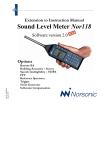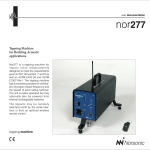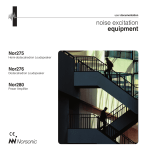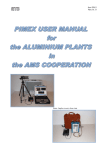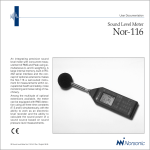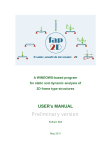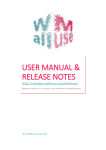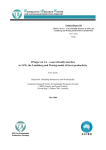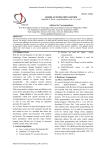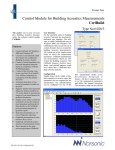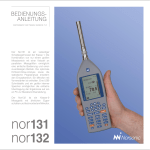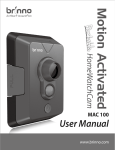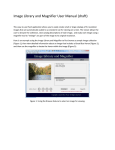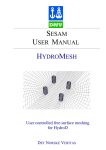Download Nor-211A User Manual - Campbell Associates
Transcript
user documentation nor211A The Nor-211A is a mains operated tapping machine with optional battery operation designed to meet the requirements given in ISO 140 parts 6 and 7 stating that a tapping machine is needed as sound source for impact noise measurements. Although the tapping machine comes with steel hammers as standard, a rubber hammer version retrofit is also available. For convenience a remote on/off control is available as an option. tapping machine Im211A _1Ed1R2En – May2004 Nor-211A User Guide Im211A_1Ed1R2En – May 2004 Edition Production Notes: This manual was created electronically using Adobe PageMaker 6.5. Artworks were made with Adobe PhotoShop 5.5 and FreeHand 8. Proofs were made on HP LaserJet 4050PS and 4MV PostScript printers. RIP and final printout were made at Allkopi, Høvik, Norway. Norsonic is a registered trademark of Norsonic AS. All other brand or product names are trademarks or registered trademarks of their respective companies. Every effort has been made to supply complete and accurate information. However, Norsonic AS assumes no responsibility for the use of – nor for the consequential damages of the use of – this information and/or the instrumentation described herein. Furthermore Norsonic AS assumes no responsibility for any infringement of the intellectual property rights of third parties, wherever applicable, which would result from such use. Norsonic AS reserves the right to amend any of the information given in this manual in order to take account of new developments. If you wish to communicate with us, please feel welcome. Our address is: Norsonic AS, P.O. Box 24, N-3421 Lierskogen, Norway. Tel: +47 3285 8900, Fax: +47 3285 2208 e-mail: [email protected] Find us on the world wide web: www.norsonic.com Copyright © Norsonic AS 1994–2004. All rights reserved Preface to this Edition Thank you for choosing Norsonic. The tapping machine Nor-211A has been designed to provide you with many years of safe, reliable operation. We recommend that you take your time to read through this little booklet before you start using the equipment. For optimum use of the tapping machine we recommend that you get yourself a copy of relevant standards applicable to you tapping machine application. Tranby, May 2004 Caution! The tapping machine Nor-211A is IP20 protected. For indoor use only! The unit must be protected from rain and dust. Moving parts! Never move the unit while it is powered. Remove the mains cable before making any check of hammer height or adjustments to the unit. 3 4 Contents 06 Introduction 07 Fall Height Adjustments 08 Changing Hammer Type 09 Making Measurements 10 Specifications 10'4" 16'8" Using the Tapping Machine Nor-211A Introduction The tapping machine Nor-211A has been designed to fulfil ISO 140 parts 6 and 7. This Standard requires a tapping machine as sound source for impact noise measurements. The requirements are as follows: • The tapping machine should have five hammers placed in a line spanning 400 mm • The time between successive impacts should be 100 ms ± 5 ms • The effective mass of each hammer should be 0.5 kg (within 2.5%) • The dropping of a hammer on a flat floor should be equivalent – with respect to the momentum – to a free, frictionless drop of 40 mm (within 2.5%). • The part of the hammer that strikes the floor should be a cylinder made of brass or steel, 3 cm in diameter, with a spherical end having a radius of 50 cm. The Nor-211A has been designed to meet these requirements. The Nor-211A/02 has been further extended to also meet the requirements for rubber coated hammers to be used on delicate floors. These rubber coated hammers are, however, easy to replace with conventional steel hammers as described later in this manual. 6 Fall Height Adjustments Before you make measurements with your Nor-211A, the fall height of all the hammers should be checked and adjusted, if needed. The check should be carried out on a flat, horizontal floor or a horizontal table. A tool for this is included, viz. the small rod mounted onto the tapping machine – see the Fig to the left. The length of this rod is 40.8mm. The 0.8mm extra has been added to compensate for the friction occurring during the fall, thereby ensuring that the effective fall is the required 40mm. Do as follows: 1. Turn the main gear until one of the hammers is at its maximum height 2. Place the rod under the hammer and verify that the hammer is less than 1mm above the top of the rod. Detach this rod and use it to check the fall height of the hammers – see text for details 3. Repeat for all hammers. The feet are locked in position by means of the screw and the nut If adjustments are needed: 1. Adjust the three feet of the tapping machine until the correct fall height (40.8mm – see above) is obtained. Make sure the machine is standing level (in both directions) while doing this. 2. Once an acceptable fall height has been reached (for all hammers) lock the position of each foot using the enclosed 19 mm wrench on the screw and the nut. Put the fall height control rod back in place. 7 Changing Hammer Type Change of hammer type applies to units supplied with extension 1 (rubber tipped hammers) only. The extension 1 includes a pin tool which fits into the hole of each hammer and a 14 mm wrench. Do as follows: 1. Insert the pin in the hole of the hammer 2. Use the 14 mm wrench as shown in the Fig. 3. Give the pin a quick push (knock it) to loosen the hammer. Do not attempt to unscrew slowly and gently as this may cause pin deformation. 4. The rubber hammers are mounted on a bracket on the end panel of the machine. The replaced set of hammers fit on the same bracket. The two types of hammers are of the same length, However, we still recommend that you verify the fall height after hammer replacement. Use the pin and the wrench when unscrewing a hammer. Give the pin a quick push rather than slowly unscrewing to avoid pin deformation 8 Operation In its standard version the unit is operated off mains, but the units equipped with option 211A/ 01 can also be battery operated by means of a buildin battery. This option cannot be installed as a retrofit. LED When connected to mains a green LED is lit. Start button The mains switch has three positions; off, ready and start/stop. The switch shall always be set to off (upper position) for safety reasons when the unit is not in use or when the fall height of the hammer is adjusted or other adjustments are done. The middle position, ready, enables the unit to receive signals from the remote control unit (optional). A green LED is lit when the switch is set to ready mode. If the LED is red, batteries (optional) need recharging. Push down the mains button starts the unit, and a second push stops it. If the unit is equipped with option 211A/03 the remote control can be used to operate the unit. Press on to begin the tapping and off to end it. Please note that a complete start/stop sequence must always be operated either from the mains switch or the remote control. E.g. starting the unit by the mains switch and stopping it from the remote control unit may cause malfunction of the on/off control of the tapping machine. After approximately 1.5 hours of operation the LED will change from green to orange colour indicating battery low (applies only to units with battery option installed) and after 2-3 hours it will change to red colour. The Nor211A will stop functioning when the battery voltage gets too low. The unit is RPM controlled by means of a feedback system. Hence, a low battery voltage will not influence the tapping speed. The remote control unit Caution! The mains switch shall always be set to Off (upper position) when the unit is not in use or when charging batteries or when the fall height of the hammer is adjusted or other adjustments are done. To recharge the batteries, just c onnect the tapping machine to mains. Charging time is approximately 12 hours. No damage is imposed if the unit is left connected to mains longer than the charging time. The mains switch should be set to off position when charging the batteries. 9 Making Measurements A measurement according to the ISO 140 part 7 will normally yield repeatable results when the room volume exceeds 25 m3. Do as follows: machine positions. For each tapping machine position in the sending room, one of six randomly distributed microphone positions is chosen in the receiving room. 1. Choose six positions at random on the floor. No position should be closer to the room boundaries (the walls) than 1.0 metre. The measuring time should always exceed 5 seconds. In cases of non-isotropic floor constructions (as will be the case with rib beam constructions), more positions may be required. Alternatively a rotating microphone boom (available separately from Norsonic AS) may be used. A minimum sweep radius of 0.7 metre is then required. The plane of the traverse should be inclined relative to the room boundaries and the microphone should never be closer to any of the room boundaries than 0.5 metre. 2. The Nor-211A should be oriented at 45° to the direction of the beams or ribs 3. The measurement of impact noise is based on absolute sound level measurements (as opposed to e.g. the relative measurements used when capturing decays for reverberation time calculations). Hence, you should calibrate your measuring equipment before you start making measurements. Consult the documentation accompanying the rest of your equipment. 4. Measure the background noise level in the receiving room. Use a bandwidth of 1/3 octave bands in the range 100 Hz to 3.15 kHz. This is the standard range for building acoustics measurements. No microphone position should be closer to the room boundaries than 0.5 m. The averaging time when measuring with a rotating boom should be equal to the traverse time of the boom, but never shorter than 30 seconds. 7. Sequentially select, measure and average the results from the other tapping machine positions in order to average out local phenomena. 8. Measure the reverberation times for the individual 1/3 octave band frequencies in the receiving room. At least three positions are required and at least two measurements should be made in each position. 5. In the sending room, start the tapping machine and verify that the excitation level is at least 10 dB above the background noise level. Check this for each individual frequency band. If this requirement fails to be met, special precautions must be taken. The equivalent absorption area A may now be calculated from A = [0.163 × V]/T and the normalised impact sound pressure level L’n may then be calculated from: 6. In the receiving room measure the sound level for the six different tapping in which A0 equals 10 m2. You will now be able to calculate Ln,W as described in ISO 717. 10 L’n = Li + 10 × log(A/A0) [dB] 1234567890123456789012345678 1234567890123456789012345678 1234567890123456789012345678 1234567890123456789012345678 SENDING ROOM 1234567890123456789012345678 1234567890123456789012345678 1234567890123456789012345678 1234567890123456789012345678 Use altogether six 1234567890123456789012345678 1234567890123456789012345678 randomly selected 1234567890123456789012345678 positions on the floor. 1234567890123456789012345678 1234567890123456789012345678 1234567890123456789012345678 1234567890123456789012345678 1234567890123456789012345678 1234567890123456789012345678 1234567890123456789012345678 1234567890123456789012345678 1234567890123456789012345678 1234567890123456789012345678 1234567890123456789012345678 1234567890123456789012345678 1234567890123456789012345678 1234567890123456789012345678 The tapping machine should 1234567890123456789012345678 1234567890123456789012345678 be oriented 45° to the direction 1234567890123456789012345678 1234567890123456789012345678 of beams or ribs 1234567890123456789012345678 1234567890123456789012345678 1234567890123456789012345678 1234567890123456789012345678 1234567890123456789012345678 1234567890123456789012345678 RECEIVING ROOM 1234567890123456789012345678 1234567890123456789012345678 1234567890123456789012345678 1234567890123456789012345678 1234567890123456789012345678 1234567890123456789012345678 1234567890123456789012345678 1234567890123456789012345678 Use one of six 1234567890123456789012345678 1234567890123456789012345678 randomly selected 1234567890123456789012345678 1234567890123456789012345678 microphone 1234567890123456789012345678 1234567890123456789012345678 positions per 1234567890123456789012345678 tapping machine 1234567890123456789012345678 1234567890123456789012345678 location, or use a 1234567890123456789012345678 1234567890123456789012345678 rotating boom 1234567890123456789012345678 1234567890123456789012345678 1234567890123456789012345678 1234567890123456789012345678 1234567890123456789012345678 1234567890123456789012345678 1234567890123456789012345678 1234567890123456789012345678 1234567890123456789012345678 1234567890123456789012345678 1234567890123456789012345678 1234567890123456789012345678 1234567890123456789012345678 1234567890123456789012345678 1234567890123456789012345678 1234567890123456789012345678 1234567890123456789012345678 1234567890123456789012345678 1234567890123456789012345678 1234567890123456789012345678 Specifications Hammers: Five hammers @ 500 g Effective fall height: 40 mm (adjustable) Tapping sequence: 10 impacts per second, rpm controlled via feedback loop Power: 100–120 V/60Hz or 200–240 V/50 Hz Battery operation (optional): from built-in Li-Ion rechargeable battery Battery operating time before recharging is required: Typ. 2 hours Battery charging time: 12 hours Fuse: 0.4 A (100–120 Vac) 0.2 A (200–240 Vac) CE conformity: EMC compliance according to EN 50081-1 and EN 50082-1 Electrical safety according to EN 61010-1-1993 Machine directive 89/392 Accessories included: Mains cable, 17 mm wrench, pin for removal of the small rod used for verification of the fall height. Units equipped with option 2 (rubber hammers) are in addition supplied with: 14 mm wrench and a special pin for removal of rubber hammers and the small verification rod. The latter replaces the pin supplied with standard versions of the Nor-211A. Power consumption: 15 W Dimensions: 72.5 × 23.0 × 32.0 [cm] (w × d × h) Weight: 10 kg (22 lbs) 12.5 kg (28.5 lbs) including option 1 (rubber hammers) Specifications subject to change without further notice. 11 Declaration of Conformity We, Norsonic AS, Gunnersbråtan 2, Tranby, Norway, declare under our sole responsibility that the product: Tapping Machine NOR-211A FROM SERIAL NUMBER 18220 to which this declaration relates, is in conformity with the following standards or other normative documents: Safety: EN61010-1:1993 for portable equipment and pollution category 2. EMC: EN 50081-1 EN 50082-1 following the provisions of the LVD-, EMC- and Machine Directive. This product has been manufactured in compliance with the provisions of the relevant internal Norsonic production standards. All our products are tested individually before they leave the factory. This Declaration of Conformity does not affect our warranty obligations. Tranby, January 1996 Dagfinn Jahr Quality Manager The declaration of conformity is given according to EN 45014 and ISO/IEC Guide 22. Norsonic AS, P.O. Box 24, N-3420 Lierskogen, Norway













